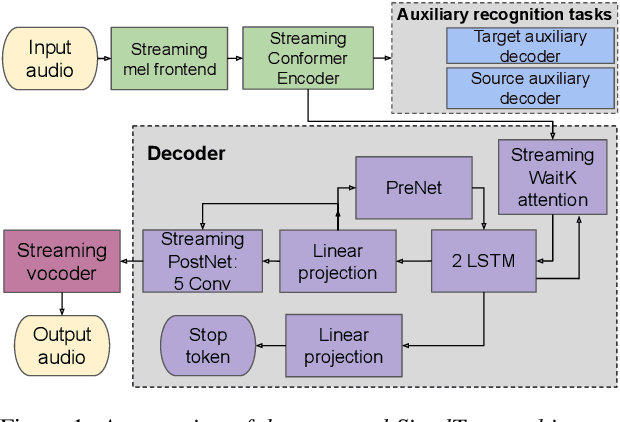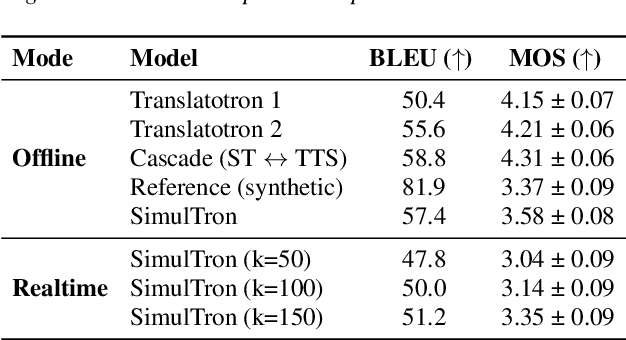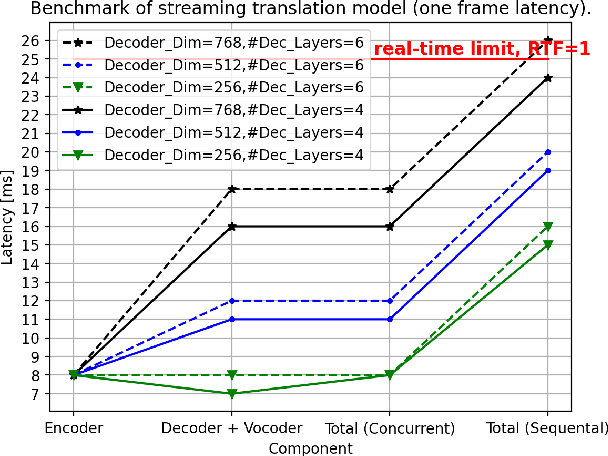Eliya Nachmani
Differential Mamba
Jul 08, 2025Abstract:Sequence models like Transformers and RNNs often overallocate attention to irrelevant context, leading to noisy intermediate representations. This degrades LLM capabilities by promoting hallucinations, weakening long-range and retrieval abilities, and reducing robustness. Recent work has shown that differential design can mitigate this issue in Transformers, improving their effectiveness across various applications. In this paper, we explore whether these techniques, originally developed for Transformers, can be applied to Mamba, a recent architecture based on selective state-space layers that achieves Transformer-level performance with greater efficiency. We show that a naive adaptation of differential design to Mamba is insufficient and requires careful architectural modifications. To address this, we introduce a novel differential mechanism for Mamba, empirically validated on language modeling benchmarks, demonstrating improved retrieval capabilities and superior performance over vanilla Mamba. Finally, we conduct extensive ablation studies and empirical analyses to justify our design choices and provide evidence that our approach effectively mitigates the overallocation problem in Mamba-based models. Our code is publicly available.
Plan for Speed -- Dilated Scheduling for Masked Diffusion Language Models
Jun 23, 2025Abstract:Masked diffusion language models (MDLM) have shown strong promise for non-autoregressive text generation, yet existing samplers act as implicit planners, selecting tokens to unmask via denoiser confidence or entropy scores. Such heuristics falter under parallel unmasking - they ignore pairwise interactions between tokens and cannot account for dependencies when unmasking multiple positions at once, limiting their inference time to traditional auto-regressive (AR) models. We introduce the Dilated-scheduled Unmasking Strategy (DUS), an inference-only, planner-model-free method that requires no additional training. DUS leverages a first-order Markov assumption to partition sequence positions into dilation-based groups of non-adjacent tokens, enabling independent, parallel unmasking steps that respect local context that minimizes the joint entropy of each iteration step. Unlike semi-AR block approaches (e.g., LLADA and Dream) that still invoke the denoiser per block, DUS reduces the number of denoiser calls to O(log B) per generation block - yielding substantial speedup over the O(B) run time of state-of-the-art diffusion models, where B is the block size in the semi-AR inference process. In experiments on math (GSM8K) and code completion (Humaneval, MBPP) benchmarks - domains suited to non-ordinal generation - DUS improves scores over parallel confidence-based planner, without modifying the underlying denoiser. DUS offers a lightweight, budget-aware approach to efficient, high-quality text generation, paving the way to unlock the true capabilities of MDLMs.
Hybrid Mamba-Transformer Decoder for Error-Correcting Codes
May 23, 2025Abstract:We introduce a novel deep learning method for decoding error correction codes based on the Mamba architecture, enhanced with Transformer layers. Our approach proposes a hybrid decoder that leverages Mamba's efficient sequential modeling while maintaining the global context capabilities of Transformers. To further improve performance, we design a novel layer-wise masking strategy applied to each Mamba layer, allowing selective attention to relevant code features at different depths. Additionally, we introduce a progressive layer-wise loss, supervising the network at intermediate stages and promoting robust feature extraction throughout the decoding process. Comprehensive experiments across a range of linear codes demonstrate that our method significantly outperforms Transformer-only decoders and standard Mamba models.
Toward Optimal ANC: Establishing Mutual Information Lower Bound
May 23, 2025Abstract:Active Noise Cancellation (ANC) algorithms aim to suppress unwanted acoustic disturbances by generating anti-noise signals that destructively interfere with the original noise in real time. Although recent deep learning-based ANC algorithms have set new performance benchmarks, there remains a shortage of theoretical limits to rigorously assess their improvements. To address this, we derive a unified lower bound on cancellation performance composed of two components. The first component is information-theoretic: it links residual error power to the fraction of disturbance entropy captured by the anti-noise signal, thereby quantifying limits imposed by information-processing capacity. The second component is support-based: it measures the irreducible error arising in frequency bands that the cancellation path cannot address, reflecting fundamental physical constraints. By taking the maximum of these two terms, our bound establishes a theoretical ceiling on the Normalized Mean Squared Error (NMSE) attainable by any ANC algorithm. We validate its tightness empirically on the NOISEX dataset under varying reverberation times, demonstrating robustness across diverse acoustic conditions.
Active Speech Enhancement: Active Speech Denoising Decliping and Deveraberation
May 22, 2025Abstract:We introduce a new paradigm for active sound modification: Active Speech Enhancement (ASE). While Active Noise Cancellation (ANC) algorithms focus on suppressing external interference, ASE goes further by actively shaping the speech signal -- both attenuating unwanted noise components and amplifying speech-relevant frequencies -- to improve intelligibility and perceptual quality. To enable this, we propose a novel Transformer-Mamba-based architecture, along with a task-specific loss function designed to jointly optimize interference suppression and signal enrichment. Our method outperforms existing baselines across multiple speech processing tasks -- including denoising, dereverberation, and declipping -- demonstrating the effectiveness of active, targeted modulation in challenging acoustic environments.
Deep Active Speech Cancellation with Multi-Band Mamba Network
Feb 03, 2025Abstract:We present a novel deep learning network for Active Speech Cancellation (ASC), advancing beyond Active Noise Cancellation (ANC) methods by effectively canceling both noise and speech signals. The proposed Multi-Band Mamba architecture segments input audio into distinct frequency bands, enabling precise anti-signal generation and improved phase alignment across frequencies. Additionally, we introduce an optimization-driven loss function that provides near-optimal supervisory signals for anti-signal generation. Experimental results demonstrate substantial performance gains, achieving up to 7.2dB improvement in ANC scenarios and 6.2dB in ASC, significantly outperforming existing methods. Audio samples are available at https://mishalydev.github.io/DeepASC-Demo
Zero-Shot Mono-to-Binaural Speech Synthesis
Dec 11, 2024Abstract:We present ZeroBAS, a neural method to synthesize binaural audio from monaural audio recordings and positional information without training on any binaural data. To our knowledge, this is the first published zero-shot neural approach to mono-to-binaural audio synthesis. Specifically, we show that a parameter-free geometric time warping and amplitude scaling based on source location suffices to get an initial binaural synthesis that can be refined by iteratively applying a pretrained denoising vocoder. Furthermore, we find this leads to generalization across room conditions, which we measure by introducing a new dataset, TUT Mono-to-Binaural, to evaluate state-of-the-art monaural-to-binaural synthesis methods on unseen conditions. Our zero-shot method is perceptually on-par with the performance of supervised methods on the standard mono-to-binaural dataset, and even surpasses them on our out-of-distribution TUT Mono-to-Binaural dataset. Our results highlight the potential of pretrained generative audio models and zero-shot learning to unlock robust binaural audio synthesis.
SimulTron: On-Device Simultaneous Speech to Speech Translation
Jun 04, 2024



Abstract:Simultaneous speech-to-speech translation (S2ST) holds the promise of breaking down communication barriers and enabling fluid conversations across languages. However, achieving accurate, real-time translation through mobile devices remains a major challenge. We introduce SimulTron, a novel S2ST architecture designed to tackle this task. SimulTron is a lightweight direct S2ST model that uses the strengths of the Translatotron framework while incorporating key modifications for streaming operation, and an adjustable fixed delay. Our experiments show that SimulTron surpasses Translatotron 2 in offline evaluations. Furthermore, real-time evaluations reveal that SimulTron improves upon the performance achieved by Translatotron 1. Additionally, SimulTron achieves superior BLEU scores and latency compared to previous real-time S2ST method on the MuST-C dataset. Significantly, we have successfully deployed SimulTron on a Pixel 7 Pro device, show its potential for simultaneous S2ST on-device.
Decision S4: Efficient Sequence-Based RL via State Spaces Layers
Jun 08, 2023Abstract:Recently, sequence learning methods have been applied to the problem of off-policy Reinforcement Learning, including the seminal work on Decision Transformers, which employs transformers for this task. Since transformers are parameter-heavy, cannot benefit from history longer than a fixed window size, and are not computed using recurrence, we set out to investigate the suitability of the S4 family of models, which are based on state-space layers and have been shown to outperform transformers, especially in modeling long-range dependencies. In this work we present two main algorithms: (i) an off-policy training procedure that works with trajectories, while still maintaining the training efficiency of the S4 model. (ii) An on-policy training procedure that is trained in a recurrent manner, benefits from long-range dependencies, and is based on a novel stable actor-critic mechanism. Our results indicate that our method outperforms multiple variants of decision transformers, as well as the other baseline methods on most tasks, while reducing the latency, number of parameters, and training time by several orders of magnitude, making our approach more suitable for real-world RL.
Translatotron 3: Speech to Speech Translation with Monolingual Data
Jun 01, 2023Abstract:This paper presents Translatotron 3, a novel approach to train a direct speech-to-speech translation model from monolingual speech-text datasets only in a fully unsupervised manner. Translatotron 3 combines masked autoencoder, unsupervised embedding mapping, and back-translation to achieve this goal. Experimental results in speech-to-speech translation tasks between Spanish and English show that Translatotron 3 outperforms a baseline cascade system, reporting 18.14 BLEU points improvement on the synthesized Unpaired-Conversational dataset. In contrast to supervised approaches that necessitate real paired data, which is unavailable, or specialized modeling to replicate para-/non-linguistic information, Translatotron 3 showcases its capability to retain para-/non-linguistic such as pauses, speaking rates, and speaker identity. Audio samples can be found in our website http://google-research.github.io/lingvo-lab/translatotron3
 Add to Chrome
Add to Chrome Add to Firefox
Add to Firefox Add to Edge
Add to Edge